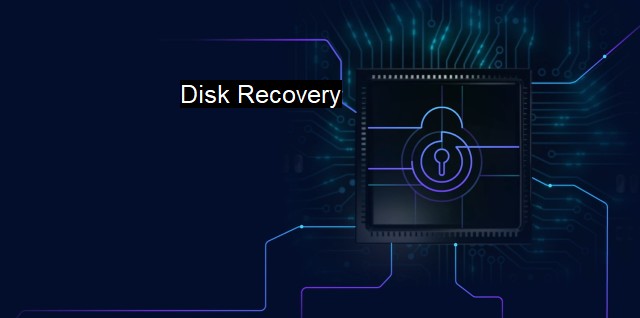What is Disk Recovery?
Exploring Disk Recovery: Types, Methods, and Best Practices for Cybersecurity and Antivirus Purposes
Disk Recovery is a vitally important technique related to cybersecurity and antivirus protection. Fundamentally, it is a process that involves the salvaging of inaccessible, lost, corrupted, damaged or formatted data from removable media, secondary storage, or files, when this data cannot ordinarily be accessed through the regular method. At times, and often unintentionally, a user may erase, or format, crucial data stored in computer hard drive by mistake. At such junctures, it is disk recovery mechanisms that can retrieve the data lost under these circumstances, offering a lifeline within cybersecurity that protects, restores, and secures crucial data information.Typically, the data that is stored on these storage media is not generally erased or damaged, regardless of what has initially caused its apparent loss or inaccessibility. Instead, the reason that the data becomes impossible to access can often be attributed to the file or directory data structures that manage them. A physical damage or non-physical damage to these structures can cause the illusion of data loss, when in fact the file data itself is often still present in individual sectors in the drive.
Disk recovery is a significant tool at a system's disposal to retrieve files affected by various physical or logical damages caused as a result of varied cyber threats, including malware, ransomware attacks, phishing techniques, and more. At times, even if a system is infected with a potent virus, and the antivirus software can contain the infection, certain files may become corrupt and remain no longer accessible. Through disk recovery, we can restore and retrieve these corrupt files, effectively mitigating the effects of such threats to cyber-security.
Antivirus software plays an equally important role in information safety and disk recovery. Modern antivirus programs are integrated with powerful disk recovery tools, which not only avert cyber threats but also initiate recovery procedures to retrieve and restore lost information. Antivirus programs continually monitor and keep track of the system for any potential malicious activities, implicating viruses or any form of cyberattack. On detecting any suspicious file behaviour, they immediately quarantine those files to prevent the infection from spreading across the system.
In case of any potential data-loss situation, these antivirus programs promptly initiate disk recovery operations. The advanced algorithmic capabilities search for lost directories, re-link user data, restore overrun files and essentially fight the malware heads on, thereby minimally impacting the system performance and capacity. Hence, the integration of disk recovery tools is an indispensable component of today’s antivirus programs.
Another critical aspect of disk recovery involves restoring information stored in secondary or cloud storage. In a connected world, entities often store data remotely, isolating it from their primary systems to safeguard it. But cyber attackers targeting these isolated, cloud-based storage systems can cause equal damage. For such situations, a different form of disk recovery comes into play, known as cloud recovery or disaster recovery. This form of recovery includes tools and methods that retrieve lost data and restore services quickly, minimising the business downtime.
As part of a cybersecurity strategy, disk recovery plays a fundamental role. It is a process designed to ensure data safety and restore lost or damaged files from storage media such as hard drives, optical disks, and other future types of secondary storage. in the context of ransomware attacks or malware infections, disk recovery utilises antivirus program capabilities to restore lost or quarantined data.
Embedding disk recovery functionality together with an antivirus solution, provides a comprehensive shield, safeguarding against a plethora of cyber threats while ensuring business continuity. By maintaining proper backups, disaster recovery plans, and efficient disk recovery tools, we can efficiently post-guard our crucial data assets, mitigating the risk of potential data loss, site downtime, and achieving an enhanced blanket of cybersecurity.

Disk Recovery FAQs
What is disk recovery?
Disk recovery, also known as data recovery, is a process of restoring lost, damaged or corrupted data from a storage device, such as a hard drive, flash drive or memory card.What are common causes for data loss?
Common causes for data loss include malware attacks, system crashes, physical damage to the device, accidental deletion or formatting, and power outages.Can I recover data from a virus-infected disk?
Yes, it is possible to recover data from a virus-infected disk, but it is important to disinfect the device before attempting any recovery. Using anti-virus software and seeking professional assistance can help prevent further damage and increase the chances of successful recovery.Is it recommended to use data recovery software?
Yes, data recovery software is a useful tool for recovering lost data, but it is important to use reliable and trusted software to avoid further damage or loss of data. Seeking professional assistance is recommended if the data is particularly valuable or if there is a risk of further damage to the device.| | A | | | B | | | C | | | D | | | E | | | F | | | G | | | H | | | I | | | J | | | K | | | L | | | M | |
| | N | | | O | | | P | | | Q | | | R | | | S | | | T | | | U | | | V | | | W | | | X | | | Y | | | Z | |
| | 1 | | | 2 | | | 3 | | | 4 | | | 7 | | | 8 | | |||||||